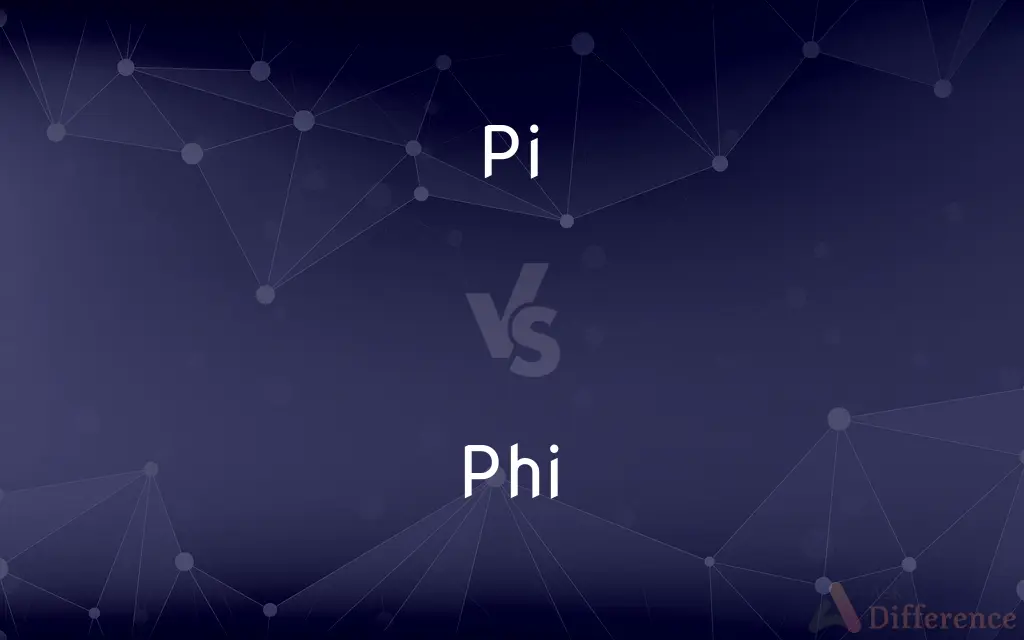Pi vs. Phi — What's the Difference?
By Tayyaba Rehman — Updated on November 7, 2023
Pi is the constant approximately equal to 3.14159, defining the ratio of a circle's circumference to its diameter, whereas Phi is the constant 1.618033, known as the golden ratio, significant in art, architecture, and natural proportions.

Difference Between Pi and Phi
Table of Contents
ADVERTISEMENT
Key Differences
Pi and Phi are both mathematical constants, but they emerge in different contexts and have distinct numerical values and properties.
Pi (π) is approximately equal to 3.14159 and is the ratio of a circle's circumference to its diameter. It is irrational and transcendental, appearing in formulas across mathematics and physics. Phi (ϕ), known as the golden ratio, is approximately 1.618033 and often symbolizes aesthetics and harmony. Its unique property is that ϕ=1+1/ϕ, and it can be found by dividing a line into two parts such that the whole length divided by the long part is also equal to the long part divided by the short part.
Comparison Chart
Numerical Value
Approximately 3.14159
Approximately 1.618033
Origin
Greek letter π
Greek letter ϕ
Context
Geometry, especially in relation to circles
Aesthetics, design, art, and nature
ADVERTISEMENT
Nature
Irrational and transcendental
Irrational
Mathematical Relation
π=C/d (Circumference/Diameter)
ϕ=1+1/ϕ
Representation
Circle's circumference to its diameter
Golden ratio, divine proportion in art/nature
Symbolism
Often represents mathematics or science
Associated with beauty, proportion, harmony
Compare with Definitions
Pi
Pi is a mathematical constant representing the ratio of circumference to diameter.
In geometry class, we learned that the value of pi is crucial for calculating the area of a circle.
Phi
Phi, known as the golden ratio, is an aesthetic principle used in art and design.
Many artists use the golden ratio, phi, to create visually pleasing compositions.
Pi
Pi is an irrational number, meaning it cannot be expressed as a simple fraction.
The digits of pi continue infinitely without repetition or pattern.
Phi
Phi appears in patterns of growth and proportions in nature.
The spirals of a nautilus shell exhibit the phi ratio in their design.
Pi
Pi is transcendental, not being a root of any non-zero polynomial equation with rational coefficients.
The transcendental nature of pi means it cannot be solved by basic algebraic equations.
Phi
Phi is an irrational number approximately equal to 1.618 and has a unique algebraic property.
The golden rectangle's sides are in the phi ratio, making it appealing to the eye.
Pi
Pi is widely used in mathematical equations involving circles and periodic functions.
Engineers use pi to calculate the stress in a circular shaft.
Phi
Phi is utilized in financial markets to predict price movements based on past trends.
Traders sometimes apply phi to determine support and resistance levels.
Pi
The number π (; spelled out as "pi") is a mathematical constant. It is defined in Euclidean geometry as the ratio of a circle's circumference to its diameter, and it also has various equivalent definitions.
Phi
Phi (; uppercase Φ, lowercase φ or ϕ; Ancient Greek: ϕεῖ pheî [pʰé͜e]; Modern Greek: φι fi [fi]) is the 21st letter of the Greek alphabet. In Archaic and Classical Greek (c.
Pi
(also pē) The 16th letter of the Greek alphabet. See Table at alphabet.
Phi
The 21st letter of the Greek alphabet. See Table at alphabet.
Pi
(Mathematics) A transcendental number, approximately 3.14159, represented by the symbol π, that expresses the ratio of the circumference to the diameter of a circle and appears as a constant in many mathematical expressions.
Phi
Φ, the 21st letter of the Euclidean and modern Greek alphabet, usually romanized as "ph".
Pi
An amount of type that has been jumbled or thrown together at random.
Phi
(mathematics) The golden ratio.
Pi
To jumble or mix up (type).
Phi
A visual illusion whereby a sequential pattern of lights produces a false sense of motion.
Pi
To become jumbled.
Phi
The 21st letter of the Greek alphabet
Pi
The 16th letter of the Classical and Modern Greek alphabets and the seventeenth in Old Greek.
Phi
Phi is associated with Fibonacci numbers, where the ratio of successive Fibonacci numbers tends to phi.
As you go higher in the Fibonacci sequence, the ratio gets closer to phi.
Pi
(mathematics) An irrational and transcendental constant representing the ratio of the circumference of a Euclidean circle to its diameter; approximately 3.14159265358979323846264338327950; usually written π.
Pi
(metal typesetting) Metal type that has been spilled, mixed together, or disordered.
Pi
(typography) pica (conventionally, 12 points = 1 pica, 6 picas ≈ 1 inch).
Pi
Piaster.
Pi
(metal typesetting) To spill or mix printing type.
Pi
(typography) Not part of the usual font character set; especially, non-Roman type or symbols as opposed to standard alphanumeric Roman type.
In computing, pi characters may be entered with special key combinations.
Pi
Pious.
Pi
A mass of type confusedly mixed or unsorted.
Pi
A Greek letter (
Pi
The letter
Pi
To put into a mixed and disordered condition, as type; to mix and disarrange the type of; as, to pi a form.
Pi
The ratio of the circumference to the diameter of a circle
Pi
Someone who can be employed as a detective to collect information
Pi
The scientist in charge of an experiment or research project
Pi
The 16th letter of the Greek alphabet
Pi
An antiviral drug used against HIV; interrupts HIV replication by binding and blocking HIV protease; often used in combination with other drugs
Pi
Pi is often celebrated on Pi Day, March 14, reflecting its approximate value of 3.14.
We ate pie on Pi Day to celebrate the mathematical constant pi.
Common Curiosities
What is pi used for?
Pi is used in mathematics to calculate properties of circles and in physics to describe periodic motions.
What does phi represent in mathematics?
In mathematics, phi represents the golden ratio, an aesthetically pleasing proportion.
How do you calculate pi?
Pi is a constant; it is not calculated but rather used as is, and it can be approximated by various infinite series.
Why is pi important?
Pi is essential in mathematics, physics, and engineering for solving problems related to circles and waves.
Is phi a transcendental number like pi?
Phi is not currently proven to be transcendental, unlike pi.
Can pi be the basis for artwork like phi?
While not typical, pi has been used in conceptual art, though phi is more common in traditional aesthetics.
Are pi and phi related?
Pi and phi are not directly related but both are mathematical constants with unique properties.
How do you find phi in a rectangle?
A rectangle's sides are in the golden ratio if the ratio of the longer side to the shorter is equal to phi.
Can pi be written as a fraction?
Pi is irrational and cannot be precisely expressed as a fraction, though 22/7 is a common approximation.
How is phi related to the Fibonacci sequence?
As you go further in the Fibonacci sequence, the ratio of successive numbers approaches phi.
Can phi be found in nature?
Yes, phi can be seen in the arrangement of leaves, the pattern of seeds in a sunflower, and other natural phenomena.
Is phi always used in art?
Phi is not always used, but many works of art and architecture have proportions close to the golden ratio.
Do pi and phi have anything in common?
Both are irrational numbers and play important roles in geometry and natural patterns.
Why is the golden ratio called phi?
The golden ratio is called phi after the Greek sculptor Phidias, who is said to have employed it in his works.
Are there any other numbers like pi and phi?
Yes, there are many mathematical constants, like e (Euler's number), with their own unique properties and uses.
Share Your Discovery

Previous Comparison
Barter vs. Swap
Next Comparison
Afternote vs. NoteAuthor Spotlight
Written by
Tayyaba RehmanTayyaba Rehman is a distinguished writer, currently serving as a primary contributor to askdifference.com. As a researcher in semantics and etymology, Tayyaba's passion for the complexity of languages and their distinctions has found a perfect home on the platform. Tayyaba delves into the intricacies of language, distinguishing between commonly confused words and phrases, thereby providing clarity for readers worldwide.












































